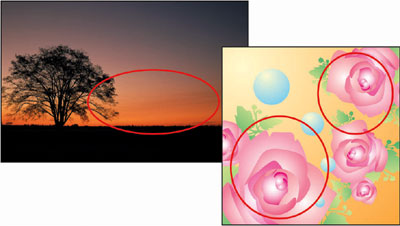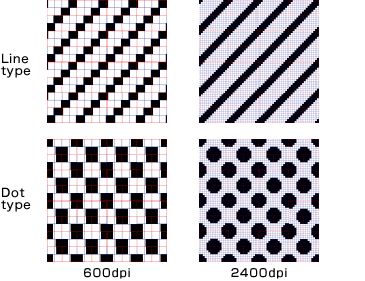HQ Digital Screen Technology
Screen processing is performed for the tone reproduction of images printed by multifunction devices or printers. Ultra-low density areas (highlights) as well as gradation and halftone areas require stable highlight reproduction and smoother gradation expression. Screen processing performance therefore becomes very important for realizing these image qualities. FUJIFILM Business Innovation has developed HQ digital screen technology that can print images in higher image quality by controlling pixels of 2400 dpi.
Conventional screen technology employed analog waves whereas the new "HQ Digital Screen MACSNote1 Technology" performs all processing digitally. Instability in an image caused by using analog waves is thus resolved and the reproduction of smooth images realized in the process of writing an image with a laser.
Fig. 1 shows enlarged photos of highlighted areas of printed outputs. The conventional 600 dpi technology offers unstable dot pattern while the 2,400 dpi HQ digital screen technology reproduces a stable image.

Fig. 1: Enlarged photos of highlighted area of printed outputs
This technology also enables the printing of high quality images by offering the reproduction of smooth gradations and beautiful highlight expressions by suppressing tone jump (color tone change) that is likely to occur in conventional screens.

Fig. 2: Improved reproducibility of gradation and halftone using HQ Digital Screen MACS Technology (circled areas)
Compared to using conventional 600 dpi technology, using this HQ Digital Screen MACS Technology improves flexibility in the number of screen lines, screen shapes, and screen angles to a level approaching commercial printing by controlling ultra fine pixels of 2,400 dpi, thereby realizing the reproduction of smooth gradations.

Fig. 3: Screen Shapes
For some products that are required to have even higher image quality, new technologies have been implemented. To improve the gradation quality, the ability to correct changes in gradation that occur over time and the bit resolution power in screen processing were increased four-fold. These enhancements enabled the reproduction of even smoother gradation.

Fig. 4: Comparison of the data conversion performance per unit area
- Note1 MACS: Micro Accurate Control Screen
FM screen
FUJIFILM Business Innovation has developed an original FM (frequency modulation) screen. FM screens are widely used in printing presses, multifunction devices, and printers because their halftone dots are randomly placed, which can help prevent moiré patterns (patterns of regular stripes) from appearing.
With the FM screen developed by FUJIFILM Business Innovation, the halftone dots are placed in a way that is geometrically optimal for xerography, significantly reducing the grainy appearance of images and allowing for higher image quality when compared to conventional FM screens. Also, by incorporating characteristics of xerography into the screen, it is possible to achieve smoother tonal reproduction and more accurate reproduction of image details. Using this new screen, it is possible to offer optimal image quality for various documents or purposes, such as for documents containing fine repeated patterns which are likely to produce a moiré effect, or for images in which minute details need to be accurately reproduced.

Fig. 5: Comparison of conventional FM screens and the new FM screen